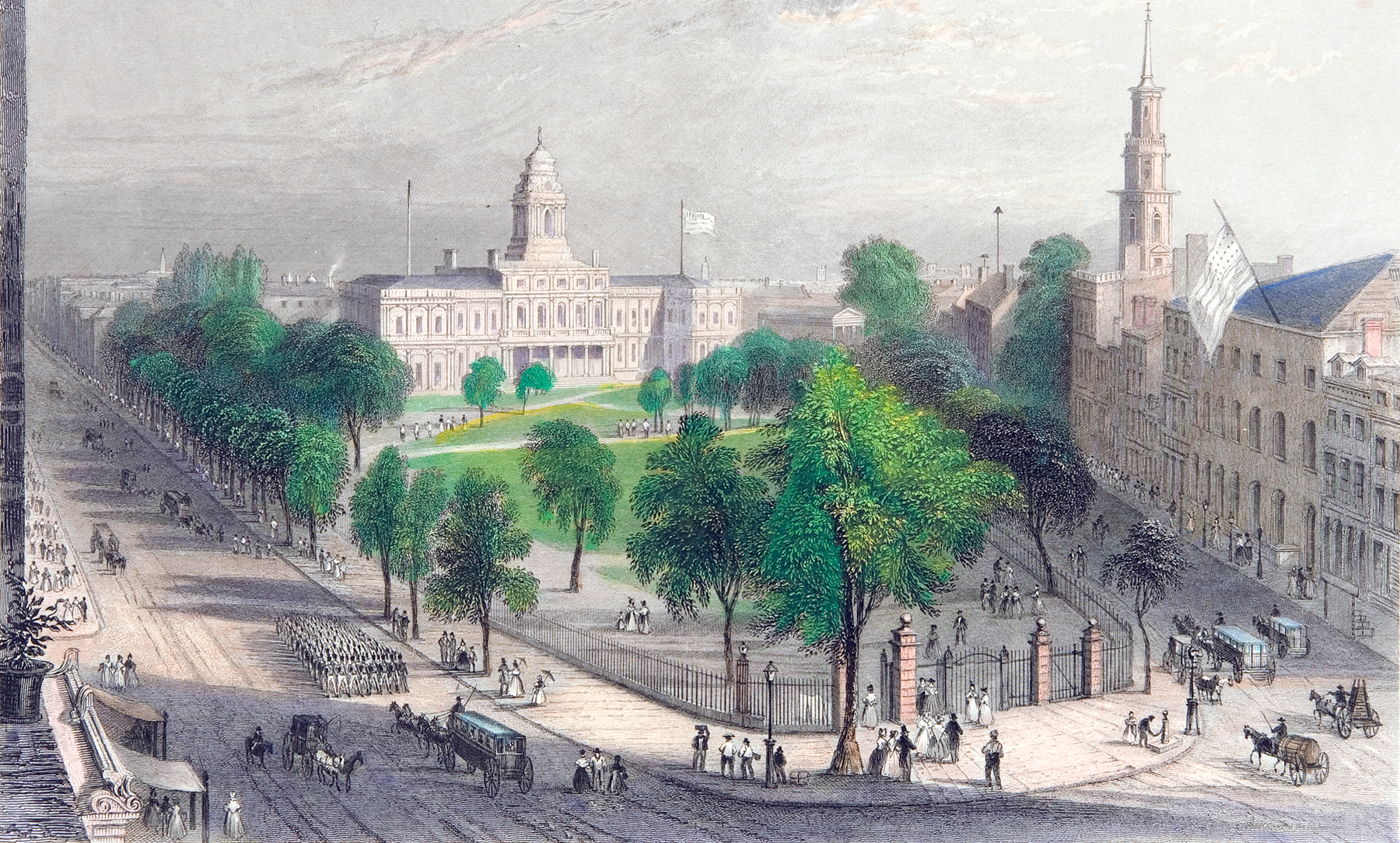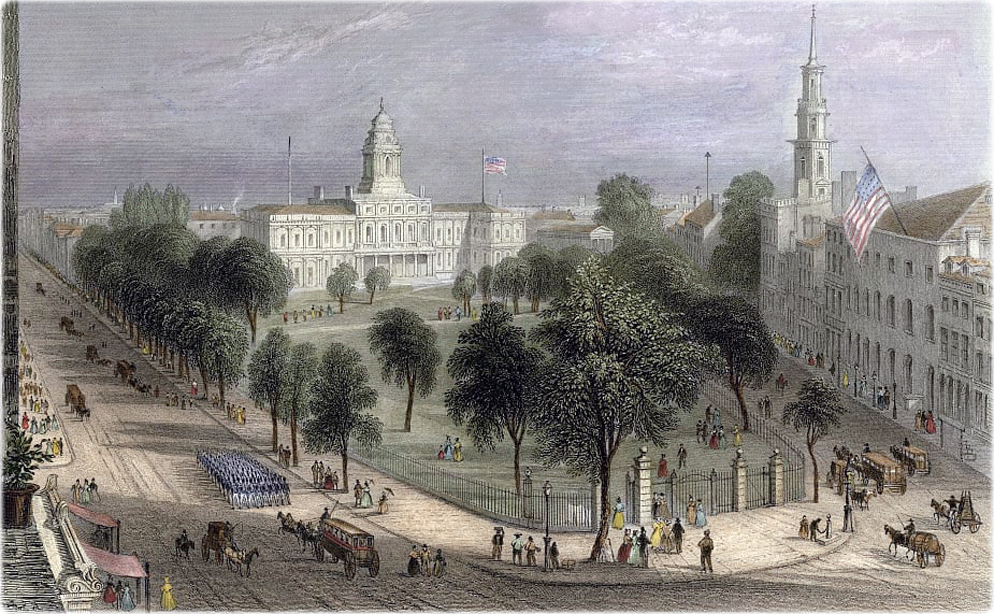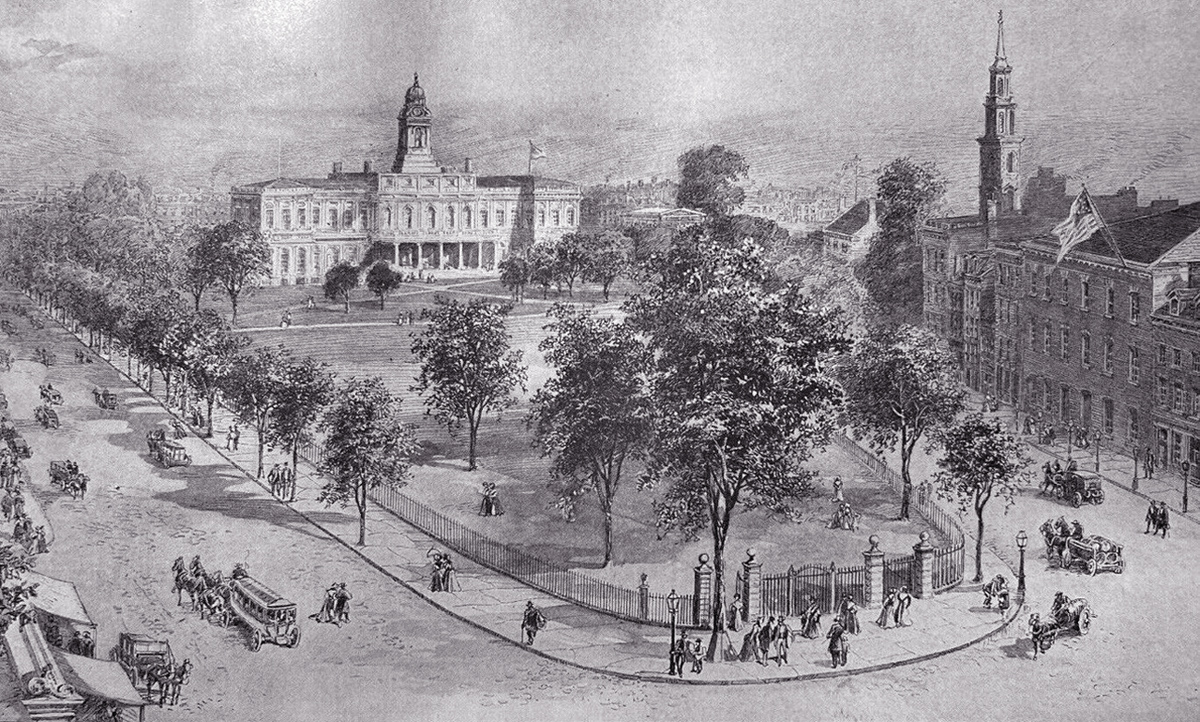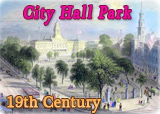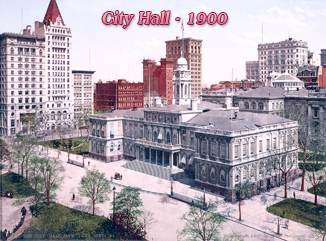The Park and City Hall, New York, looking northeast from the west side of Broadway.
View of City Hall Park from the
southern end. The buildings of Park
Row are shown at right. A troop of soldiers marches down Broadway at left.
Hand-colored engraving by Samuel Lacey (British, 1787–1859), after drawing by
William Henry Bartlett (British, 1809–1854). Published by George Virtue
(British, 1793–1868), London,
1838. Source: Yale University Art Gallery.
The New York City Hall opened in 1812. Note that there was no fountain yet. The Croton Fountain was placed in the center of the Park in 1842. The iron railing fence surrounding the Park was built in 1818 and completed in 1821, replacing the old post and rail fence built in 1785.
The illustration above was published in the American Scenery by Nathaniel Parker Willis, London, 1840, accompanied by the following text:
«The first Stadt Huys in this city was constructed of stone, and stood originally at the head of Coenties Slip, facing on Pearl Street, towards the East river. It was built as early in the Dutch dynasty as 1642, and became so weakened and impaired in half a century afterwards, that the court sitting there recommended it to be sold, and another to be constructed. In 1699, they sold the old building for nine hundred and twenty pounds, “reserving only the bell, the king’s arms, and iron works (fetters) belonging to the prison.” By the agreement, leave was granted “that the cage, pillory, and stocks, before the same, be removed any time within one year, and the prisoners in the city hall to remain one month.” “In front of all these, on the river, was placed the Rondeal, or Half-Moon Fort, where it probably assisted the party sheltered in the City Hall, while the civil war prevailed.”
The new building must have been finished in 1700. It stood at the head of Broad Street, fronting on Wall Street; and its lower story formed an open arcade over the foot pavement. It was also the proper prison of the city, and had before it, on Broad Street, a whipping-post, pillory, &c. There were also held the sessions of the Provincial Assembly, the Supreme Court, and the Mayor and Admiralty Courts. It was finally altered to suit the Congress; and at that time the prisoners were moved to the new jail in the park; but the Congress removing to Philadelphia, it was again altered to receive the courts and the State Assembly.
“It was in the gallery of the old City Hall, on Wall Street,” says Watson in his Annals, “that General Washington was inaugurated the first President of the United States. The oath of office was taken in the open gallery in front of the Senate Chamber, in the view of an immense concourse of citizens. There this nobleman of nature, with his noble height and port, in a suit of dark silk velvet of the old cut, steel-hilted small sword by his side, hair in bag and full powdered, in black silk hose, and shoes with silver buckles, made his pledge on a quarto Bible, still preserved in St. John’s Lodge. How uprightly, intelligently, and disinterestedly, he executed his task, history will never cease to tell to his fame and glory.”
The present City Hall was erected in 1803, at an expense of half a million of dollars. The front and sides are constructed of white marble, and the remainder of red sandstone. It is a beautiful edifice, and only wants elevation. When the trees of the park are in full leaf, it is difficult to get an entire view of it.
The park is the centre of New York, and its two most thronged and finest avenues form the two sides of it. Broadway, the much crowded and much praised Broadway, the Corso, the Toledo, the Regent Street, of New York, pours its tide of population past the western side of the verdant triangle, and, just at the park, its crowd and its bustle are thickest. Broadway is a noble street, and on its broad side-walks may be seen every thing that walks the world in the shape of a foreigner, or a fashion—beauties by the score, and men of business by the thousand; but, besides every possible ingredient of continental crowds, there are to be seen in Broadway two additional classes of peripatetics seen never on foreign pavés but in rare specimens—coloured dandies, and belligerent pigs. The former take the wall of you, and the latter, when the question of passing on one side or the other becomes embarrassing, escape with great dexterity between your legs.
It would be difficult in one day to describe the prevailing style of dress in Broadway, for fashions have become unfashionable, and each man and woman dresses as Fortune pleases. ...
“Men wore three-square, or cocked hats, and wigs; coats with large cuffs, and big skirts lined and stiffened with buckram. The coat of a beau had three or four large plaits in the skirts, and wadding, like a coverlet, to keep them smooth. The cuffs were very large, up to the elbows, open below, and loaded with lead to keep them down. The cape was thin and low, so as readily to expose the close-plaited neck-stock of fine linen cambric, and the large silver stock-buckle on the back of the neck. The shirts were worn with hand-ruffles, and sleeve-buttons were worn at the wrist, of precious stones, or gold. The little boys wore wigs, like their elders, and their dresses generally were similar to those of the men. Coats of red plush were very fashionable, and the breeches were commonly made of this material.”
We refer the reader to Watson’s Annals for many curious particulars touching the apparel and habits of the New Yorkers in the early part of the last century.»
